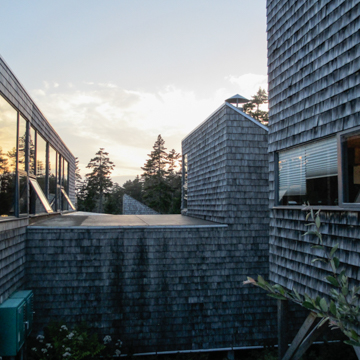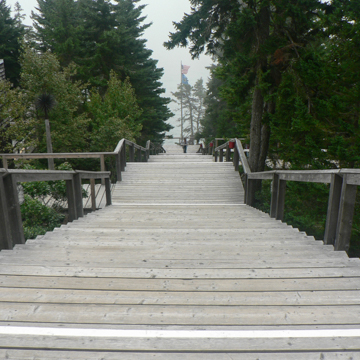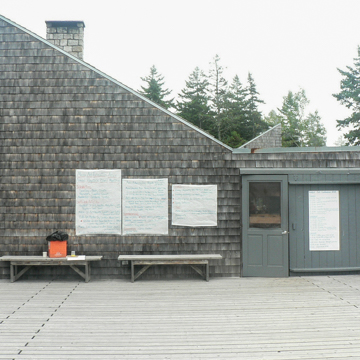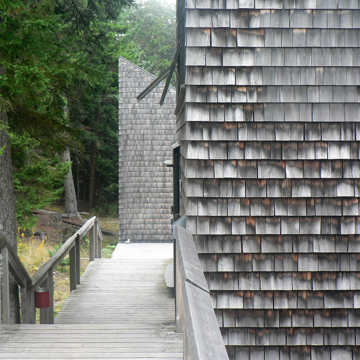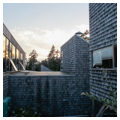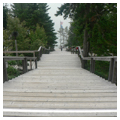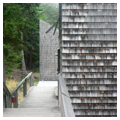Designed in 1959, the Haystack Mountain School of Crafts on Deer Isle is heralded as one of architect Edward Larrabee Barnes’s greatest achievements. The thirty-five buildings of the Haystack campus—simple, modernist, wood forms seated on wood platforms—are artistically arranged in a verdant landscape of evergreen trees and wooden walkways with dazzling ocean views. Barnes’s architectural creation harmonizes seamlessly with its natural landscape and with the contemplative and creative mission of the school.
The school was founded in 1950 by a group of Maine artists at Montville near Haystack Mountain. Supported by benefactor Mary Beason Bishop, the first campus occupied an old farmstead and consisted of a lodge, print shop, pottery shed, and farmhouse converted into a wood shop. The school offered studio-based workshops in a variety of mediums, including clay, glass, metals, paper, blacksmithing, and woodworking. When highway construction forced the school to move in 1961, the Haystack Trustees chose Barnes, the distinguished architect, to build a new thematically unified modernist arts campus. The new campus would sit on 42 acres of steeply sloping land overlooking Jericho Bay on Deer Isle.
All buildings at Haystack are based on a simple module. The basic module is a 10-foot-wide by 16-foot-long, balloon-framed, shingled structure, two stories high on one side and one story on the other; its pitched roof runs parallel to the shore and the walkways. In the cabin module, triangular windows occupy the upper side walls of each structure. A plain, painted entrance door graces the one-story wall and ribbon windows are positioned on the lower half of the taller wall. The most common form, however, of which there are 18 examples on the campus, is the two-module cabin. Measuring 20 by 16 feet, the single unit cabin includes small bathrooms, while the remaining double and all the triple units are not plumbed. There are also two dormitory units consisting of three conjoined modules without interior partitions.
Barnes arranged the modular buildings in a pattern intended to link the built environment to the natural surroundings. Through their siting on the sloping verdant terrain leading to the sea, and through the wooden walkways connecting building to building, the vernacular modules seem to “float” as if in a marina. The peaked roofs of the module design mimic the sails visible on the bay. Wooden walkways and decks artfully draped on the slop of a craggy knoll at the Northeast corner of Deer Isle link the campus buildings. Haystack originally comprised a 26-module campus of cabins, dormitories, dining halls, ceramic and fiber studios, metal and wood shops, and offices. Between 1959 and 2004 Barnes oversaw the addition of more studios, an auditorium, library, and store building. Most of the buildings are clustered on the 8 acres of land sloping toward the bay. The remainder of the land is dedicated to nature trails and a narrow dirt access road with limiting parking.
At the center of the main campus is a 142-step staircase oriented on a north–south axis. The steps lead to a “flag deck” seated over the water’s edge 55 feet below. Except for the office modules, all the campus buildings adjoin the decks or walkways that connect at right angles to the main staircase. All sit in the shadow of spruce and tall pine trees and with views of the Deer Isle Thoroughfare and the bay. Local sculptor George Greenamyer designed a steel bell tower in 1968–1969.
Barnes graduated from Harvard 1942, where he studied under Marcel Breuer and Walter Gropius. After serving in World War II, Barnes opened an architectural office in New York City. Among his best known works are the Walker Art Center in Minneapolis (1971, 1984), the Asia Society in New York City (1980), and the Dallas Museum of Art (1983). In addition to Haystack, Barnes’s other well-known Maine commission was the Heckscher House (1971–1974). The Haystack School represents somewhat of a departure from the rigid modernist ethic. At Haystack, Barnes executed an architectural vocabulary centered on strict attention to the human scale, to ease of movement, exposure to sunlight, and, most importantly, simplicity. The scale of Barnes’s Haystack campus was intimate, humanizing, and obtainable.
References
Thompson, Deborah, ed. Maine Forms of American Architecture. Waterville, ME: Colby Museum of Art, 1976.
Mitchell, Christi A. “Haystack Mountain School of Crafts,” Hancock County, Maine. National Register of Historic Places Inventory-Nomination Form, 2005. National Park Service, U.S. Department of the Interior, Washington, D.C.
“Accent on Architecture: The AIA Twenty-Five Year Award to Haystack Mountain School of Crafts.” Architectural Record, February 1, 1994, 54.







